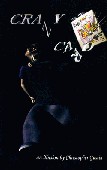Crazy Card
Gustin, Christopher
Murphy's Magic Supplies
(Based on 1 review)

Includes a 10 page, fully illustrated instruction booklet detailing the routine step by step.
- Over 40 Illustrated photos
- Performance tips
- Performance rights
- Leaves your spectator with their selected and signed card to keep as a souvenir
- Leaves you with a reusable deck
Available from your favorite magic dealer.
Reviews
(Top ▲)
The basic plot of Crazy Card is one that you may be familiar with. From a blue backed deck a card is selected, signed, and returned. The card is then located in some way and found to be the only one with a red back. Crazy Card offers the following twist on this classic plot: Color changes. Mr. Gustin really likes color changes.
In Crazy Card, the selected card is located without the signature and a color change is used to restore it. The selection is shown to have a blue back and a color change is used to change it to a red back. This last color change is one of my least favorites (the snap color change) as the angles are bad and clean-up is a hassle -- a good "camera trick" as they say. To get everything working as described, a good bit of knuckle busting is employed (ie. double lifts, false shuffles, steals, jogs, palming, and of course color changes).
It's quite a bit of work, and not for the beginner, but is it worth it? Well, I suppose that depends on how much you value the added visual effect of the color changes. Personally, I don't really care for them here and in fact believe that they distract from the primary effect. If the color changes, however, appeal to you then by all means give this a shot.
If you decide to give it a shot then for the love of (insert favorite deity here) don't pay any attention to the last two photos in the booklet. These pictures purport to show the difference between a gambler's cup (sic) and a classic palm. To be fair, the hand positions do look very different, but what's shown is the BACK of the hands. Call me old fashioned, but I'd like to think that the back of the hands should look nearly identical. What the pictures do have in common is the number one tip off that you are hiding something in your hand. That is, the thumbs stick out like, well... sore thumbs! Regarding the classic palm, Roberto Giobbi, in Card College, Volume 2, p.272 counsels "Take care that your thumb lies alongside the hand and does not stick out like a fish hook (a frequently encountered flaw)." Sore thumb. Fish hook. Why quibble? Just pretend those photos aren't there. (Oh, and see Card College, Volume 3, p.708 for information on the gambler's cop.)
If the added color changes and/or technical demands don't really appeal to you, then you might consider Dark Card or Lips as an alternative. Dark Card is a real fooler and Lips is a very commercial version of this classic card plot. Either can be found for under $10(US).
2 1/2 stars
In Crazy Card, the selected card is located without the signature and a color change is used to restore it. The selection is shown to have a blue back and a color change is used to change it to a red back. This last color change is one of my least favorites (the snap color change) as the angles are bad and clean-up is a hassle -- a good "camera trick" as they say. To get everything working as described, a good bit of knuckle busting is employed (ie. double lifts, false shuffles, steals, jogs, palming, and of course color changes).
It's quite a bit of work, and not for the beginner, but is it worth it? Well, I suppose that depends on how much you value the added visual effect of the color changes. Personally, I don't really care for them here and in fact believe that they distract from the primary effect. If the color changes, however, appeal to you then by all means give this a shot.
If you decide to give it a shot then for the love of (insert favorite deity here) don't pay any attention to the last two photos in the booklet. These pictures purport to show the difference between a gambler's cup (sic) and a classic palm. To be fair, the hand positions do look very different, but what's shown is the BACK of the hands. Call me old fashioned, but I'd like to think that the back of the hands should look nearly identical. What the pictures do have in common is the number one tip off that you are hiding something in your hand. That is, the thumbs stick out like, well... sore thumbs! Regarding the classic palm, Roberto Giobbi, in Card College, Volume 2, p.272 counsels "Take care that your thumb lies alongside the hand and does not stick out like a fish hook (a frequently encountered flaw)." Sore thumb. Fish hook. Why quibble? Just pretend those photos aren't there. (Oh, and see Card College, Volume 3, p.708 for information on the gambler's cop.)
If the added color changes and/or technical demands don't really appeal to you, then you might consider Dark Card or Lips as an alternative. Dark Card is a real fooler and Lips is a very commercial version of this classic card plot. Either can be found for under $10(US).
2 1/2 stars









